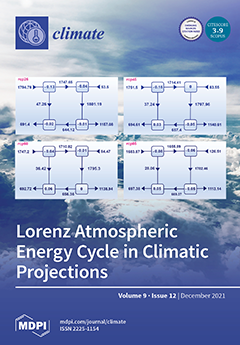The solar radiation climate of Greece is investigated by using typical meteorological years (TMYs) at 43 locations in Greece based on a period of 10 years (2007–2016). These TMYs include hourly values of global, H
g, and diffuse, H
d, horizontal irradiances from which the direct, H
b, horizontal irradiance is estimated. Use of the diffuse fraction, k
d, and the definition of the direct-beam fraction, k
b, is made. Solar maps of annual mean H
g, H
d, k
d, and k
b are prepared over Greece under clear and all skies, which show interesting but explainable patterns. Additionally, the intra-annual and seasonal variabilities of these parameters are presented and regression equations are provided. It is found that H
b has a negative linear relationship with k
d; the same applies to H
g with respect to k
d or with respect to the latitude of the site. It is shown that k
d (k
b) can reflect the scattering (absorption) effects of the atmosphere on solar radiation, and, therefore, this parameter can be used as a scattering (absorption) index. An analysis shows that the influence of solar variability (sunspot cycle) on the H
g levels over Athens in the period 1953–2018 was less dominant than the anthropogenic (air-pollution) footprint that caused the global dimming effect.
Full article





